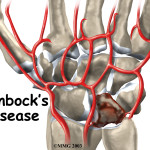CYCLOPS LESION – SOME KIND OF MONSTER?
Cyclops lesions are an unfortunate sequelae of anterior cruciate ligament injury, and are most commonly seen following ACL reconstructions. The cyclops lesion is a consequence of a localised form of anterior arthrofibrosis. This results in the formation of a nodule of fibrous tissue in the anterior portion of the ACL graft (Tonin et al., 2001). The cyclops lesion sits in the anterior margin of the intercondylar notch, just above the tibial tunnel, which can become impinged between the tibia and femur upon knee extension (Bradley et al., 2000).
Cyclops lesions after ACL reconstructions have a reported incidence that is generally around 4% (Sonnery-Cottet et al., 2010). The pathogenesis of cyclops lesions is likely multi-factorial. It is understemmed by natural fibroproliferative processes secondary to either drilling debris, ACL stump remnants, or broken graft fibres (Delince et al., 1998). Delince et al (1998) also suggest that the cyclops lesion may be a result of inappropriate surgical technique, including poor graft positioning (I would not advise telling your patients this though…).
CLINICAL PRESENTATION OF A CYCLOPS LESION
The clinical presentation of a cyclops lesion varies between patients, however, your suspicion would be raised with the following clinical findings (Sonner-Cottet et al., 2010; Tonin et al., 2001):
SUBJECTIVE:
- Commonly symptomatic – anterior knee pain with extension
- Patients report issues with lying supine, walking and running
- Sometimes patients report an audible clunk with extension
OBJECTIVE:
- Loss of extension ROM (generally about 10 degrees): typically 2 – 3 months following reconstruction
- Extension ROM sometime reproduces audible clunk
- Quadriceps dysfunction, associated with extension deficit
- Swelling often present
MR IMAGING:
Bradley et al. (2000) examined the diagnostic accuracy of MRI results, as compared with arthroscopic findings, at establishing the presence of a cyclops lesion. There findings are summarised in the table below.
MANAGEMENT OF CYCLOPS LESION
PHYSIOTHERAPY MANAGEMENT OF CYCLOPS LESIONS
Unfortunately it has been shown that aggressive physiotherapy management frequently fails to improve these patients (Shelbourne et al., 1994; Mariani et al., 1992). Thus, our role in this case is to flick them back to their orthopaedic surgeon.
SURGICAL MANAGEMENT OF CYCLOPS LESIONS
The optimal form of management for a cyclops lesion is arthroscopic debridement. This has been shown to provide good to great results in the majority of patients. At follow-up Sonnery-Cottet et al. (2010) found that 85.7% of patients had restoration of full ROM and 78.5% were graded A on the IKDC objective evaluation. Similar results were shown in a smaller study by Wang and Ao (2009), who found restoration of full extension ROM in all 6 patients following arthroscopic debridement.
CYCLOPS LESIONS DURING ARTHROSCOPY
This video shows the assessment of a cylcops lesion, and the impingement between tibia and femur that prevents full extension.
TAKE HOME MESSAGES
- Cyclops Lesion occur in about 4% of ACL reconstructions
- Loss of extension ROM at 2 – 3 months following reconstruction is a hallmark sign
- Symptoms also include extension related pain, swelling and quads dysfunction
- MRI is a useful diagnostic tool
- Surgical management is indicated, as conservative physiotherapy management often fails
- Outcomes of surgical debridement of cyclops lesions are good
What are your experiences with Cyclops Lesions?? Hit me up in the comments or catch me on Facebook or Twitter
If you require any sports physiotherapy products be sure check out PhysioSupplies (AUS) or MedEx Supply (Worldwide)
REFERENCES
Bradley DM, Bergman AG, Dillingham MF. MR Imaging of Cyclops Lesions. AJR 2000; 174:719-726
Delince P, Descamps PY, Fabeck L, Hardy D. Different aspects of the cyclops lesion following anterior cruciate ligament reconstruction: A multifactorial etiopathogenesis. Arthroscopy 1998 14(8): 869-876
Mariani PP, Ferretti A, Conteduca F, Tudisco C. Arthroscopic treatment of flexion deformity after ACL reconstruction. Arthroscopy 1992;8:517–521
Shelbourne KD, Johnson GE. Outpatient surgical management of arthrofibrosis after anterior cruciate ligament surgery. Am J Sports Med 1994;22: 192–197
Sonnery-Cottet B, Lavoie F, Ogassawara R, Kasmaoui H, Scussiato RG, Kidder JF, Chambat P. Clinical and operative characteristics of cyclops syndrome after double-bundle anterior cruciate ligament reconstruction. Arthroscopy 2010 26(11):1483-8
Tonin M, Saciri V, Veselko M, Rotter A. Loss of Knee Extension after Injury : Cyclops Syndrome due to a Lesion of the Anterior Cruciate Ligament. Am J Sports Med 2001 29: 545
Wang J, Ao Y. Analysis of Different Kinds of Cyclops Lesions With or Without Extension Loss. Arthroscopy 2009 25(6):626-631
Related Posts
Comments









thankyou that was a very valuable article I have a 2.1cm cylops lesion in my knee. i have marked swelling and severe pain. I did have my knee ACL reconstructed by using the Hamstring muscle in 2002. i then had to have a notchplasty in 2005. I have suffered instabiltiy in the joint for many years i was wondering what your advice would be and would like to know if the impingemnet in my knee could be causing pain down into my foot and up into my hip
thankyou
Trish,
I’m wondering if you received a response to your inquiry?
I am 3 yrs post hamstring ACL reconstruction, and 2 yrs post meniscus arthroscopy (meniscus needed clean up from bucket handle tear repair caused by ACL blow out. Both injuries were repaired at same time).
At this time I am having pain up and down my leg as you describe. I know I have a bakers cycst, but doc indicates this would not cause this type of pain. I have not had another MRI – doc indicates since I have had so much repair it would not offer any conclusive info.
Thanks for any info you could share,
Ruth